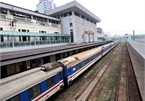
The ministry has asked the Railway Project Management Unit to carry out the pre-feasibility study for the project, which was designed to pass link HCMC and localities in the Mekong Delta, including Can Tho City, Long An, Tien Giang and Vinh Long, the local media reported.
Under the new plan, the railway will be 135 kilometers long, down five kilometers and a station compared with the previous plan, as the railway will run parallel to the right of the HCMC-Trung Luong-My Thuan-Can Tho Expressway.
The route will start at the Tan Kien Station in HCMC’s Binh Chanh District and end at Can Tho’s Cai Rang District. The project will include a 44-kilometer branch from Thanh Phu Station to Long An Port in Long An Province and Hiep Phuoc Port in HCMC.
The main route will include nine urban stations—Tan Kien in HCMC; Thanh Phu and Tan An in Long An; Tan Phuoc, Cai Lay and Cai Be in Tien Giang; Vinh Long and Binh Minh in Vinh Long and Can Tho in Can Tho city. The branch will have two stations—Long Dinh and Can Giuoc in Long An.
Public traffic facilities, houses, schools, hospitals and supermarkets will be developed near the urban stations. The railway will have a depot in Tan Kien Commune, Binh Chanh District.
The project was proposed to be a double-track line, allowing a maximum speed of 200 kilometers per hour for passenger trains and 150 kilometers per hour for cargo trains.
The total investment in the project was estimated at some US$10 billion. The investor will operate it for 25 years to recover capital and then hand it over to the Ministry of Transport.
Once the railway is completed, it will take 45 minutes to travel from HCMC to Can Tho instead of the current five to six hours and the capacity to transport cargo from HCMC and the Mekong Delta will be enhanced.
In 2018, the project was proposed to have a length of over 139 kilometers, down one kilometer from the initial plan. This solution would also help take advantage of the cleared site for the HCMC-Trung Luong and Trung Luong-My Thuan expressways. However, the line remained long, required a huge investment and caused difficulties while adjusting the planning of the urban stations.
A representative of the Southern Institute of Science and Technology said the HCMC-Can Tho railway project had attracted more than 20 sources of investment from many countries and international financial funds.
The HCMC government has approved a plan to develop the logistics sector by 2025 with a vision to 2030, asking for the development of five high-speed railways, including the HCMC-Can Tho route.
SGT

Railways revenues take $57.4 million hit from COVID
The Vietnam Railways Corporation has lost VND1.32 trillion (US$57.4 million) in revenues due to the COVID-19 pandemic and flooding in the central region.